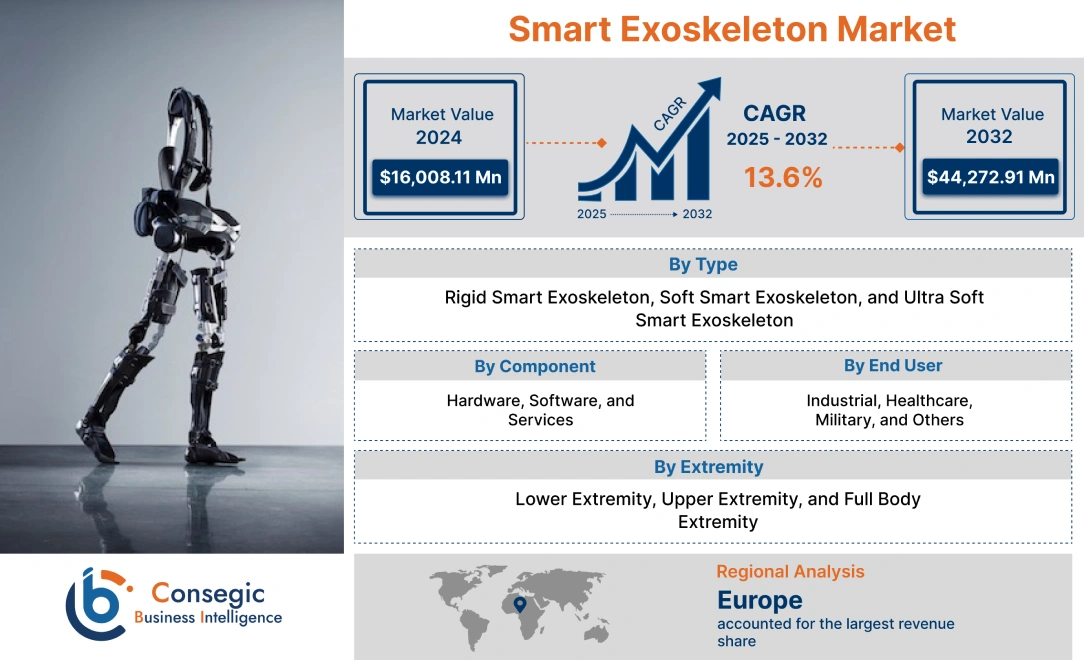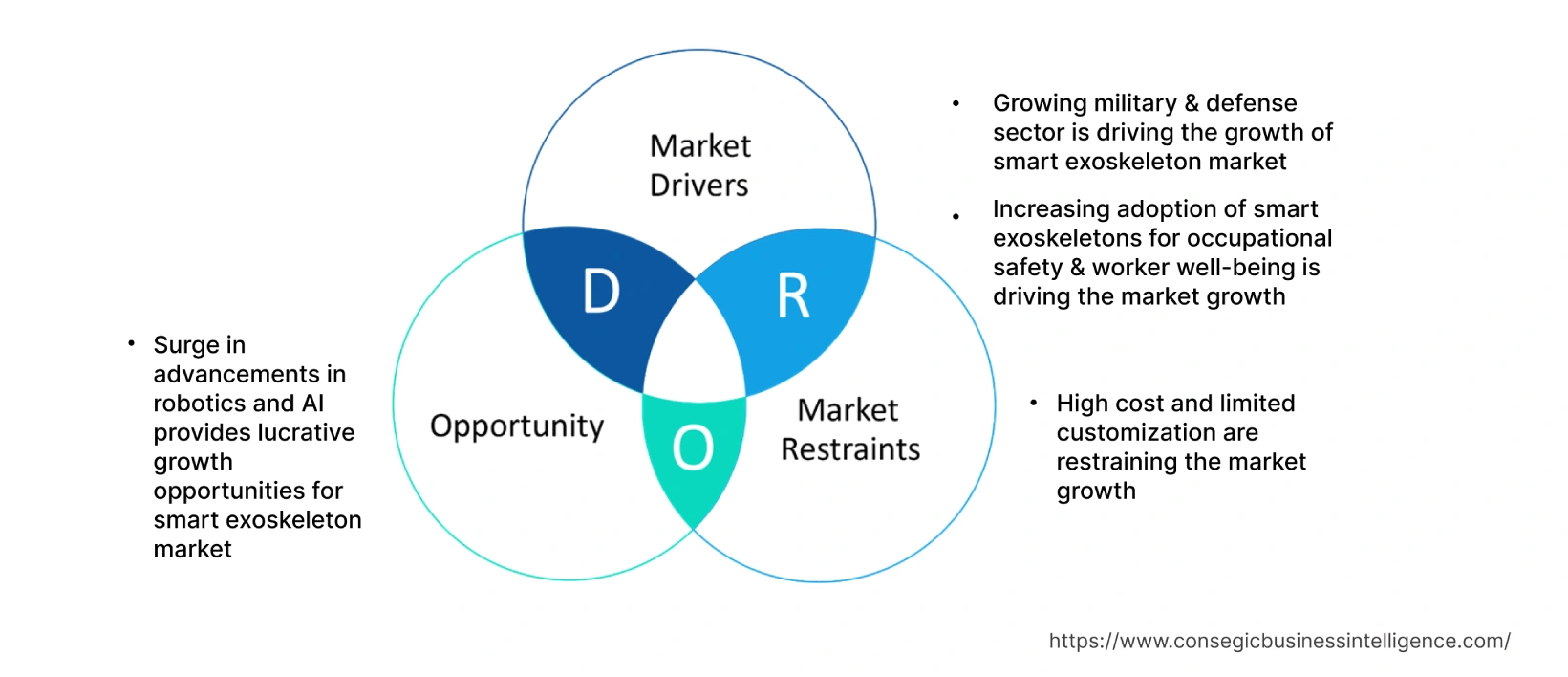- Summary
- Table Of Content
- Methodology
Smart Exoskeleton Market Size :
Smart Exoskeleton Market size is estimated to reach over USD 18,208.60 Million by 2032 from a value of USD 6,542.23 Million in 2024 and is projected to grow by USD 7,318.68 Million in 2025, growing at a CAGR of 13.60% from 2025 to 2032.
Smart Exoskeleton Market Scope & Overview:
Smart exoskeletons are wearable robotic devices designed to enhance human capabilities, assist with mobility, augment physical strength, and reduce physical strain. They incorporate advanced technologies including sensors, actuators, and artificial intelligence to assist users with mobility, strength, and endurance. These devices are deployed in a wide range of applications in healthcare, industrial, and military sectors. As per the analysis, the smart exoskeleton market demand is propelled by several factors including an aging population, increasing focus on worker safety & well-being, and rising demand for enhanced performance in physically demanding environments.
Smart Exoskeleton Market Insights :
Key Drivers :
Growing military & defense sector is driving the growth of smart exoskeleton market
Smart exoskeletons are widely deployed in the military & defense sector to enhance the physical capabilities of soldiers and improve their performance during missions and training. The use of t exoskeletons enables soldiers to carry heavier loads, move more efficiently, and perform physically demanding tasks with reduced fatigue. Additionally, they play a vital role in reducing the physical strain of the soldiers by distributing the weight more evenly across the body, providing support, and reducing the physical burden, thus allowing them to move more efficiently. Also, application of these exoskeletons in military & defense industry also reduces the risk of injuries to soldiers that are caused by improper movement and strain in the body. Thus, as per the analysis, owing to the aforementioned factors, increasing adoption of exoskeletons in military & defense sector is driving the global smart exoskeleton market growth. For instance, in September 2021, Arizona State University developed exoskeletons for the U.S. military. The exoskeletons provide hip stability and back stability to the soldiers in turn enhancing the heavy lifting activity.
Increasing adoption of smart exoskeletons for occupational safety & worker well-being is driving the market
Smart exoskeletons are deployed in several industries including automotive, mining, construction, logistics, and others to improve the safety, well-being, and productivity of the workers. Reducing physical pain is considered to be one of the key factors driving the adoption of these exoskeletons in industries. The exoskeletons tend to reduce the physical strain on workers' bodies by aiding in lifting and supporting loads, thereby reducing the risk of overexertion and musculoskeletal injuries. For instance, the GERMAN BIONIC SYSTEMS GMBH manufactures Cray X, a exoskeleton that enables workers to list and walk conveniently with up to 30kg weight. Thus, the factors mentioned above are driving the adoption of these exoskeletons across industries to enhance occupational safety & worker well-being.
Key Restraints :
High cost and limited customization are restraining the market
The smart exoskeletons are considered to be expensive to develop, manufacture, and purchase, making them less accessible for many potential users and industries. Additionally, high cost of the exoskeletons restricts the adoption from small businesses and companies. Moreover, as per the analysis, the exoskeletons are mass produced and might not cater to the individual users' specific needs or body types. Thus, limited scope of customization is restraining the adoption of these exoskeletons for users with unique requirements.
Future Opportunities :
Surge in advancements in robotics and AI provides lucrative opportunities for smart exoskeleton market
Rapid progress and innovation in robotics and artificial intelligence (AI) technologies are expected to provide significant smart exoskeleton market opportunities for the global smart exoskeleton market trends. Advancements in sensor technologies enable these exoskeletons to gather real-time data about the user's movements, posture, and biomechanics. Additionally, AI and machine learning algorithms play a vital role in exoskeleton. They are crucial in analyzing the data collected by the sensors and making real-time adjustments to the exoskeleton's support based on the user's movements and intentions. Also, AI and machine learning ensure that the exoskeleton provides optimal assistance and reduces the need for manual adjustments. For instance, the Apogee exoskeleton by GERMAN BIONIC SYSTEMS GMBH is integrated with AI and machine learning to analyze the user's movements for improving workplace and individual safety practices and ergonomics. Thus, the advancements in robotics and AI provides lucrative opportunities and trends in the upcoming years.
Smart Exoskeleton Market Report Insights :
| Report Attributes | Report Details |
| Study Timeline | 2019-2032 |
| Market Size in 2032 | USD 18,208.60 Million |
| CAGR (2025-2032) | 13.6% |
| By Component | Hardware, Software, and Services |
| By Type | Rigid Smart Exoskeleton, Soft Smart Exoskeleton, and Ultra Soft Smart Exoskeleton |
| By Extremity | Lower Extremity, Upper Extremity, and Full Body Extremity |
| By End User | Industrial, Healthcare, Military, and Others |
| By Region | North America, Europe, Asia-Pacific, Latin America, and Middle East & Africa |
| Key Players | Ekso Bionics, ReWalk Robotics, CYBERDYNE INC., Sarcos Technology and Robotics Corporation, Suitx, Hyundai Motor Company, GERMAN BIONIC SYSTEMS GMBH, COMAU (Stellantis N.V.), BIONIK, Fourier Intelligence, Gogoa.eu |
Smart Exoskeleton Market Segmental Analysis :
By Component :
Based on the component, the market is segregated into hardware, software, and services. The hardware segment accounted for the largest smart exoskeleton market share of 48.63% in the year 2024. The hardware components of these exoskeletons include sensors, actuators, microcontrollers, mechanical structures, and others. These components play a crucial role in enabling the devices to function effectively. The actuators provide the necessary power to assist the wearer's movements or perform specific tasks. Similarly, as per the analysis, the sensors provide critical data to the exoskeleton's control system to enable adjustment support and assistance in real-time. Thus, attributing to the aforementioned factors, hardware accounted for largest market share and trends in 2022.
The software segment is anticipated to register the fastest CAGR during the forecast period. They rely on sophisticated control algorithms to synchronize collected data. The software component plays a vital role in real-time monitoring, personalized adjustments, and data analysis to optimize the exoskeleton's performance for individual users. For instance, in December 2021, GERMAN BIONIC SYSTEMS GMBH launched the 5th generation Cray X AI-powered smart exoskeleton for applications including walking assistance, lifting support, and others. Additionally, the rising requirement for upgraded software to aid in tracking progress and identifying potential improvements in exoskeleton's design and functionality is expected to positively impact the segment development and trends during the forecast period.
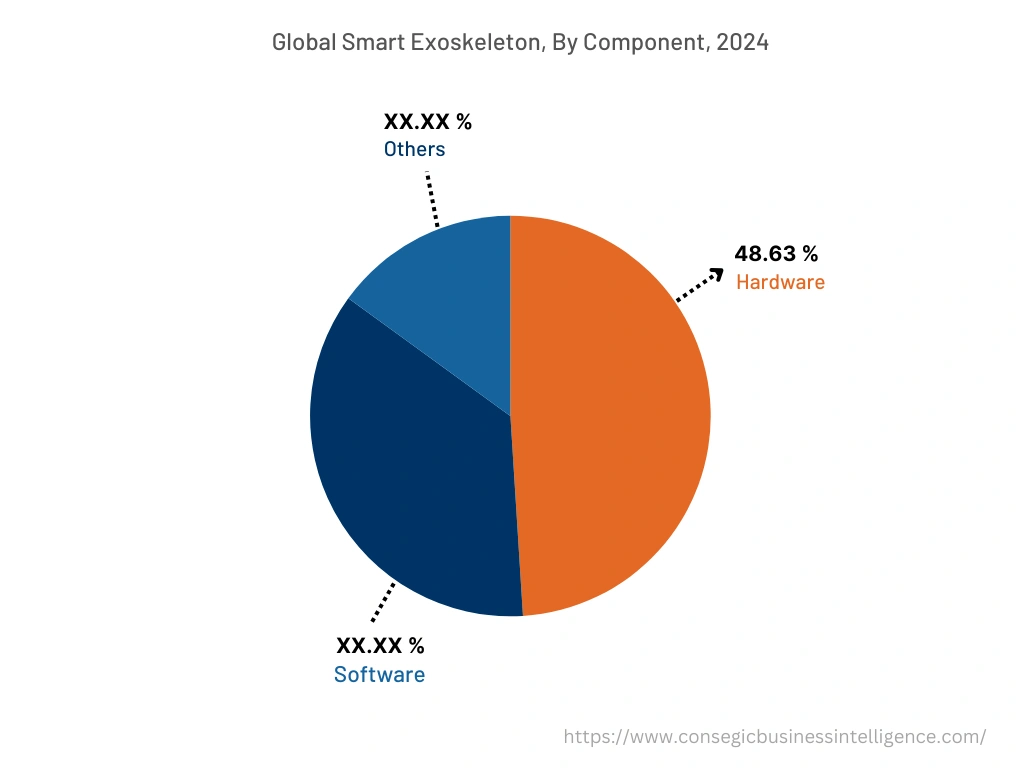
By Type :
Based on the type, the market is classified as rigid, soft, and ultra soft. The rigid exoskeleton segment accounted for the largest revenue share in the year 2024. The rigid exoskeletons are constructed with rigid materials including metal or carbon fiber. Rising requirement for rigid exoskeletons for application including heavy lifting, load-bearing tasks, and others from a wide range of industries such as construction, manufacturing, and others are driving the market. Moreover, increasing requirement for rigid exoskeletons from the military & defense sector is another factor boosting the segment expansion and trends.
The soft exoskeleton segment is anticipated to witness the fastest CAGR during the forecast period. The soft exoskeletons utilize flexible materials such as textiles and elastic elements. Also, based on the analysis, soft exoskeletons are considered to be lightweight and more comfortable to wear than rigid exoskeletons. Surge in adoption of soft exoskeletons to provide assistance to specific body movements including joint motion enhancement or supporting specific muscle groups. Furthermore, factors including comfort & wearability, flexibility & natural movements, rehabilitation & physical therapy, and user-friendly interface among others are anticipated to drive the demand and trend for soft exoskeletons during the forecast period.
By Extremity :
Based on extremity, the market is classified into lower extremity, upper extremity, and full body extremity. The upper extremity segment accounted for the largest revenue share in the year 2024. The upper extremity exoskeletons are designed to support and enhance the functions of arms, shoulders, and hands. Exoskeletons are widely used for applications that involve lifting, reaching, and performing repetitive upper body movements. Additionally, the upper body extremity exoskeletons play a vital role in reducing muscle fatigue and the risk of musculoskeletal injuries in industrial settings. Moreover, the growing adoption of upper extremity exoskeletons from logistics sector is considered to be one of the major factors driving the market. Thus, the growing logistics sector is driving the demand for upper-extremity exoskeletons. For instance, Logistics Plus Inc. the air freight industry transports approximately 51.2 million tons of cargo annually. Thus, the aforementioned factors are propelling the segment trends.
The full body extremity segment is anticipated to witness the fastest CAGR during the forecast period. The full body exoskeletons A full-body extremity exoskeleton is a wearable robotic device that is designed to assist and augment human movements across the entire body including arms, legs, and others. A surge in demand for full body extremity suits from military and industrial sectors is expected to drive the segment expansion and trends during the forecast period.
By End-User :
Based on the end user, the market is categorized as industrial, healthcare, military, and others. The industrial segment accounted for the largest revenue share in the year 2024. They play a vital role in reducing physical strain and injuries for workers performing repetitive tasks, heavy lifting, and enable worker safety in industrial environments. Rise in demand of smart exosuits to enhance worker efficiency and productivity is considered to be major factor driving the market. Additionally, the ability of the exoskeletons to reduce risk associated with health of the workers is another key factor fueling the market trends.
The military segment is anticipated to witness the fastest CAGR during the forecast period. Smart exosuits are used in the military and defense sector for several applications including soldier enhancement, injury prevention, and remote operations among others. Exoskeletons are crucial in enabling soldiers to carry heavy loads over long distances on foot. Moreover, growing investments in the military sector is expected to fuel market growth during the forecast period. For instance, according to the Stockholm International Peace Research Institute, the global expenditure on military sector increased by 3.7% in 2022 accounting for USD 2,240 billion. Thus, the aforementioned factors are propelling the market trends in the upcoming years.
By Region :
The regional segment includes North America, Europe, Asia Pacific, Middle East and Africa, and Latin America.
Europe accounted for the largest revenue share of 36.78% in the year 2024 valued at USD 1,771.15 million. Presence of significant number of players including ReWalk Robotics, GERMAN BIONIC SYSTEMS GMBH, COMAU (Stellantis N.V.), and Gogoa.eu among others is one of the major factors driving the market growth in the region. Additionally, the rapidly ageing population is another key factor driving the adoption of these exoskeletons to provide assistance to seniors with mobility issues in the region. For instance, according to the Eurostat, the European region accounted for 21.1% of population above the age of 65 years.
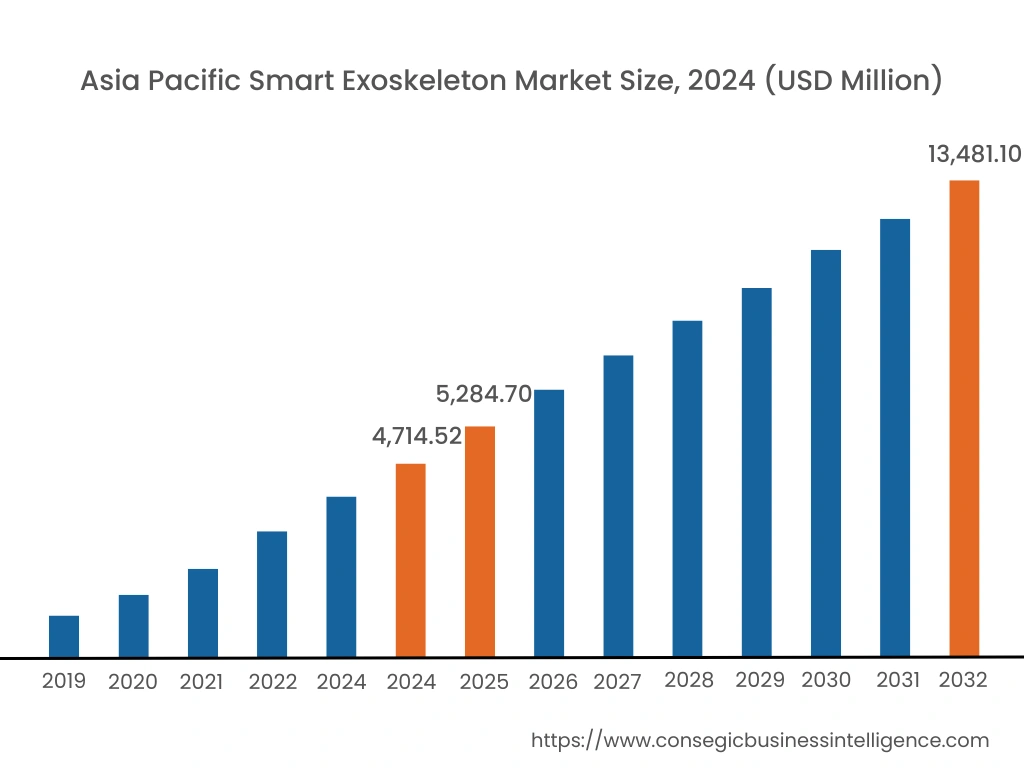
The Asia-Pacific region is anticipated to witness the fastest CAGR of 14.1% during the forecast period. Further, the region was valued at USD 1,926.74 Million in 2024. Moreover, it is projected to grow by USD 2,161.50 Million in 2025 and reach over USD 5,544.52 Million by 2032. In addition, China accounted for the maximum revenue share of 33.40% in the same year. Based on the smart exoskeleton market analysis, surge in trend towards industrial automation in Asia Pacific region is expected to be one of the major factors to enhance worker efficiency and improve productivity. Additionally, rising improvements in healthcare and increasing awareness of rehabilitation technologies is anticipated to positively impact the growth of smart exoskeleton market in Asia Pacific region during the forecast period.
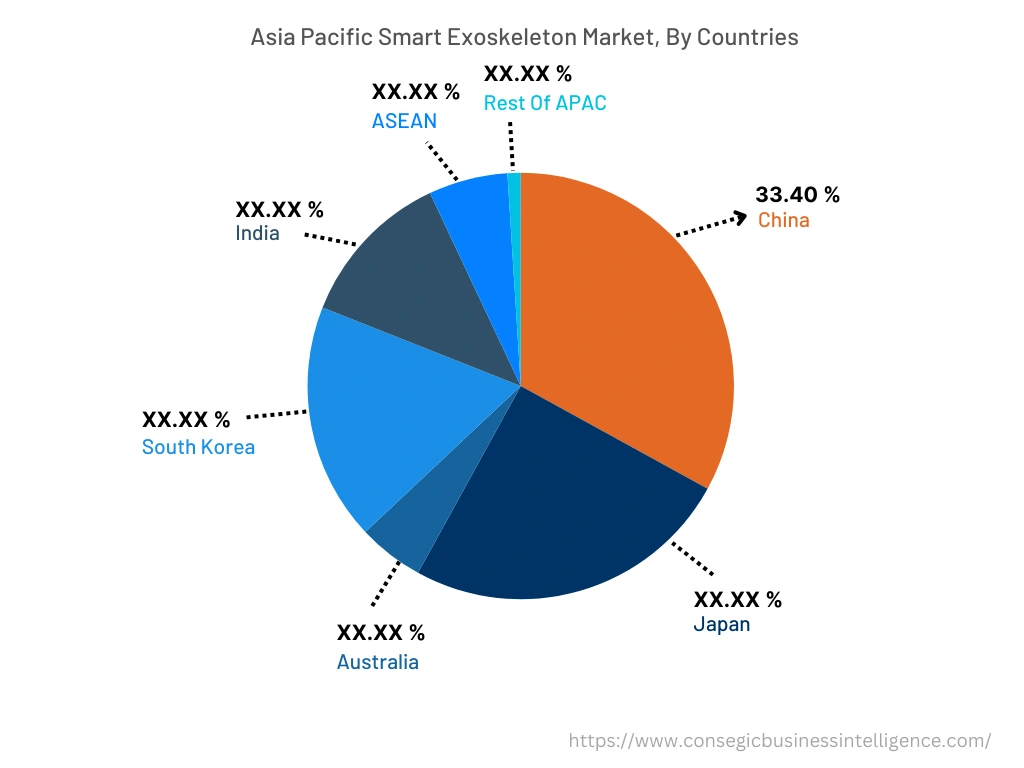
Top Key Players & Market Share Insights:
The Smart Exoskeleton Market is highly competitive due to the presence of a large number of key players operating in the market. The Report analyses detailed profiles of the major players operating in the smart exoskeleton industry. Further, the surge in Research and Development (R&D), product innovation, various business strategies, and application launches have accelerated the growth of the robotic process automation market. Key players in the robotic process automation market include-
- Ekso Bionics
- ReWalk Robotics
- BIONIK
- Fourier Intelligence
- Gogoa.eu
- CYBERDYNE INC.
- Sarcos Technology and Robotics Corporation
- Suitx
- Hyundai Motor Company
- GERMAN BIONIC SYSTEMS GMBH
- COMAU (Stellantis N.V.)
Recent Industry Developments :
- In December 2021, GERMAN BIONIC SYSTEMS GMBH launched the 5th generation Cray X AI-powered smart exoskeleton for applications including walking assistance, lifting support, and others.
Key Questions Answered in the Report
What is Smart Exoskeleton? +
Smart exoskeletons are wearable robotic devices designed to enhance human capabilities, assist with mobility, augment physical strength, and reduce physical strain.
What specific segmentation details are covered in the Smart Exoskeleton Market Report, and how is the dominating segment impacting the market growth? +
The Report consists of segments including Component, Type, Extremity, and End User. Each segment has key dominating sub-segment being driven by the industry trends and market dynamics. For instance, by component segment has witnessed hardware as the dominating segment in the year 2024 to enable the devices to function effectively.
What specific segmentation details are covered in the Smart Exoskeleton Market Report, and how is the fastest segment anticipated to impact the market growth? +
The Report consists of segments including Component, Type, Extremity, and End User. Each segment is projected to have the fastest-growing sub-segment being fuelled by industry trends and drivers. For instance, by extremity segment has witnessed upper extremity as the fastest-growing segment due to surge in demand for full body extremity suits from military and industrial sectors.
Which region/country is anticipated to witness the highest CAGR during the forecast period, 2025-2032? +
The Asia-Pacific region is anticipated to witness fastest CAGR growth during the forecast period due to rising improvements in healthcare and increasing awareness of rehabilitation technologies.
